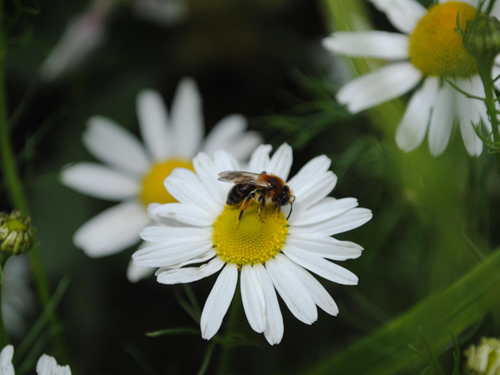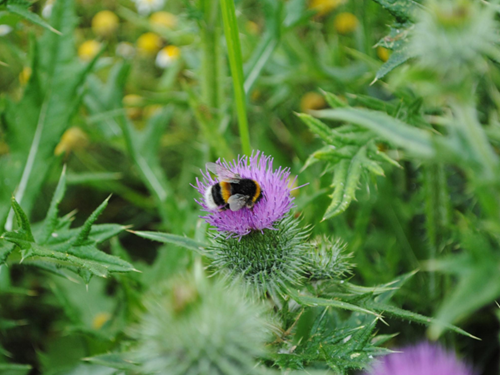By Jayna Connelly, Science Communicator
The UK is home to around 270 different bee species. Just one of these is the familiar honeybee, another 24 are bumblebees, and the rest are solitary species that are often overlooked or mistaken for flies or flying ants. Despite their smaller size, solitary bees are just as important as their larger relatives when it comes to pollination.
Each species of pollinator is adapted to a slightly different role in nature. Some have long tongues that allow them to feed from deep, bell-shaped flowers, while others are short-tongued and rely on flatter, open blooms. The variety of flowers across our countryside exists because of it has evolved with this incredible diversity of bees, each one specialising in different plants. Contrary to what many people assume, honeybees are not the most efficient pollinators. They collect pollen carefully to turn into honey, which means less is shared between flowers. Wild bees such as bumblebees are far more effective because they readily drop pollen as they move from one flower to the next, fertilising more plants in the process.

One of the biggest challenges our bees face is what conservationists call “the hungry gap.” This is the time of year, particularly through late winter and early spring, when few flowers are in bloom and food is scarce. To help bees survive, it is important to provide a succession of flowering plants that come into bloom at different times, ensuring that nectar and pollen are available throughout the season.
The Game & Wildlife Conservation Trust (GWCT) has carried out many years of research to develop seed mixes that farmers can plant in field margins to provide reliable food for wild pollinators. From this work we now know that a handful of flower species are especially important to bees on farmland, including dandelion, wild carrot, hedgerow cranesbill, smooth hawksbeard, rough hawkbit, spear thistle, ox-eye daisy, knapweed and cow parsley. Hedges can also provide vital resources, but only if they are allowed to flower. That means avoiding annual cutting and instead trimming on a three-year cycle so that hawthorn and other flowering shrubs have the chance to bloom.

As the climate warms, bees are also changing their behaviour. Buff-tailed bumblebees have even been spotted trying to establish colonies in January, a sign of how longer mild spells are altering their life cycles. Most bee species, however, still rely on very particular survival strategies. Honeybees are the only species in the UK that keep a colony going over winter. Bumblebees die off in autumn, leaving only the queens to hibernate underground until spring, while solitary bees depend entirely on their pupae to carry the population through the cold months.

There are also quirks to their behaviour that remind us just how ingenious bees can be. Some honeybees and short-tongued bumblebees have learned to “rob” nectar by biting into the base of deep flowers that they cannot otherwise reach. And while we often think of bees living in hives, most do not. Solitary bees prefer bare earth, mammal burrows, reeds, leaf litter or tussocky grass to nest in, and many of them can even be encouraged into bee hotels.
Bees are far more than a summer soundtrack. They are the engine behind much of the pollination that sustains our crops, our wildflowers, and the wider health of the countryside. With the right support, from flower-rich field margins and hedgerows to better awareness of their life cycles, we can begin to reverse their declines and secure their future.
Show your support for bees
Wild bees are vital pollinators, each adapted to specific flowers depending on tongue length and habitat. Long-tongued bees prefer bell-shaped flowers, while short-tongued species favour flat, open ones. Unlike honeybees, which hold onto pollen to make honey, wild bees like bumblebees pollinate more effectively by readily dropping pollen between flowers.
To support bees, it's crucial to ensure a continuous supply of flowers throughout the season. GWCT research has helped develop seed mixes to optimise farmland habitat for bees, including key species such as dandelion, wild carrot, hedgerow cranesbill, smooth hawksbeard, rough hawkbit and spear thistle.
You can now show your support for the future of bees with a GWCT special edition Bee Badge! By buying a badge today you are helping us to continue this vital work. Visit the GWCT Shop.